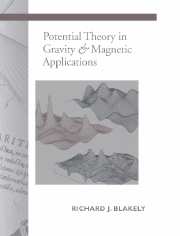Book contents
- Frontmatter
- Contents
- Introduction
- 1 The Potential
- 2 Consequences of the Potential
- 3 Newtonian Potential
- 4 Magnetic Potential
- 5 Magnetization
- 6 Spherical Harmonic Analysis
- 7 Regional Gravity Fields
- 8 The Geomagnetic Field
- 9 Forward Method
- 10 Inverse Method
- 11 Fourier-Domain Modeling
- 12 Transformations
- Appendix A Review of Vector Calculus
- Appendix B Subroutines
- Appendix C Review of Sampling Theory
- Appendix D Conversion of Units
- Bibliography
- Index
6 - Spherical Harmonic Analysis
Published online by Cambridge University Press: 10 October 2009
- Frontmatter
- Contents
- Introduction
- 1 The Potential
- 2 Consequences of the Potential
- 3 Newtonian Potential
- 4 Magnetic Potential
- 5 Magnetization
- 6 Spherical Harmonic Analysis
- 7 Regional Gravity Fields
- 8 The Geomagnetic Field
- 9 Forward Method
- 10 Inverse Method
- 11 Fourier-Domain Modeling
- 12 Transformations
- Appendix A Review of Vector Calculus
- Appendix B Subroutines
- Appendix C Review of Sampling Theory
- Appendix D Conversion of Units
- Bibliography
- Index
Summary
But that to say in difficult problems the use of spherical harmonics is laborious is not to slight the method, because any other accurate treatment would be still more difficult.
(Sydney Chapman and Julius Bartels)Gravity is the ballast of the soul, which keeps the mind steady.
(Thomas Fuller)Physical quantities measured on or above the earth's surface are naturally suited to mathematical descriptions in spherical coordinates. The most common such framework is spherical harmonic analysis. Spherical harmonic analysis can be useful for any reasonably well-behaved, global phenomenon and has been applied to a diverse range of data, from free oscillations of the earth to global climate change. At the very least, spherical harmonic analysis provides a way to synthesize from a scatter of discrete measurements on a sphere an equation applicable to the entire sphere. Such an equation then can be used to interpolate the behavior of the phenomenon to regions of the sphere that have no measurements.
As the name implies, however, spherical harmonic analysis takes on special meaning when applied to potential fields, because the building blocks of spherical harmonic analysis are a natural consequence of Laplace's equation in spherical coordinates. In particular, the various terms of a spherical harmonic expansion are sometimes related (with caution) to specific physical phenomena. The most well-known example is the separation of the dipole and nondipole components of the geomagnetic field: A spherical harmonic expansion based on discrete measurements of the geomagnetic field directly provides separate descriptions of the dipole and nondipole fields, and these two fields often are attributed to separate but linked processes in the earth's core.
- Type
- Chapter
- Information
- Potential Theory in Gravity and Magnetic Applications , pp. 100 - 127Publisher: Cambridge University PressPrint publication year: 1995



